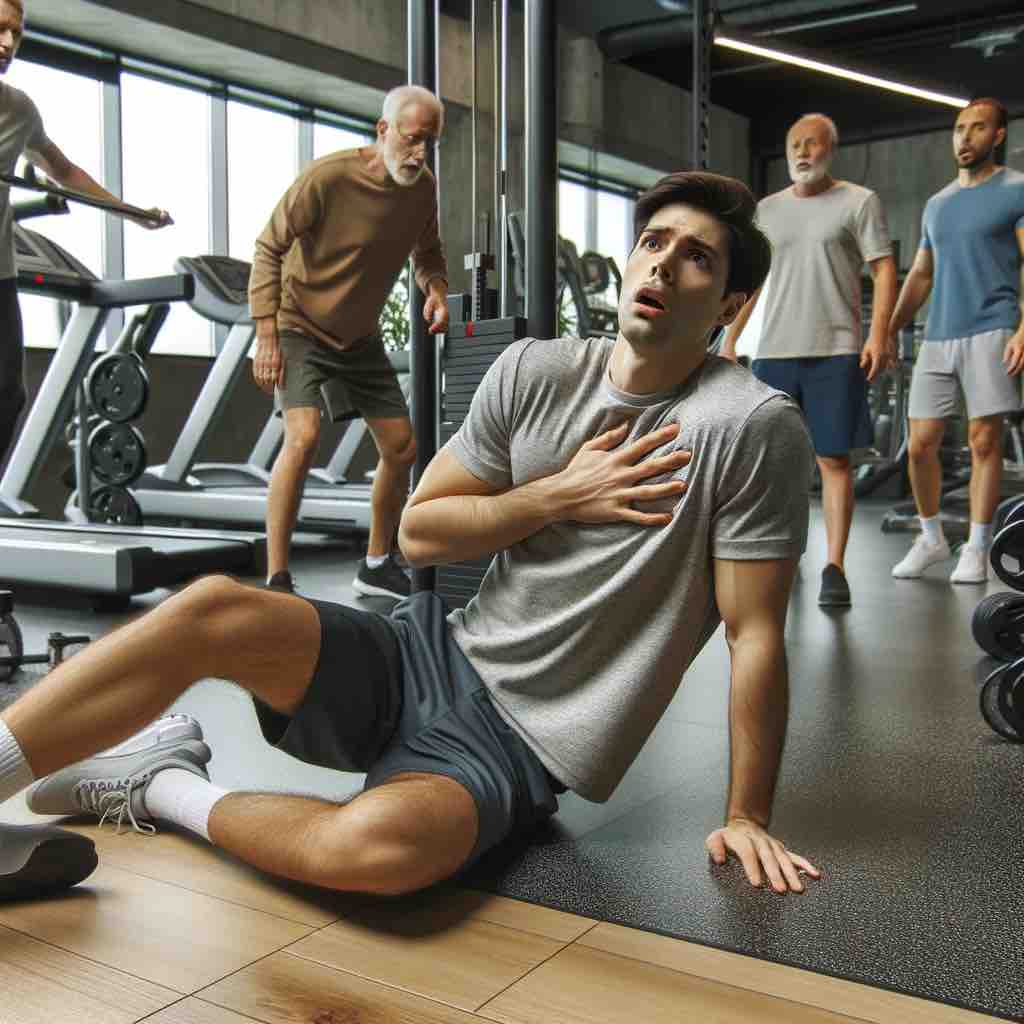Do you have a sedentary lifestyle? How often do you put your body into motion?
Exercise is vital for maintaining good health as it strengthens your cardiovascular system, improves muscle tone, and enhances mental wellness. However, it’s likely to experience occasional dizziness during physical exertion.
You might wonder, “Am I doing something wrong?” or “Am I sick?”
To understand the causes and find the right solution to these symptoms, continue reading this article and brace yourself for an improved fitness routine.
- Origins of Dizziness During Exercise
- Consequences of Ignoring Lightheadedness While Working Out
- How to Prevent Dizziness
- Foods to Eat to Avoid Dizziness
Today’s Focus of Attention is reader-supported. We sometimes include products we think are useful for our readers. If you buy through links on this page, we may earn a small commission.
Potential Origins of Dizziness During Exercise
Several factors may affect your performance inside your workout journey, including inadequate breathing, overexertion, dehydration, low blood sugar and pressure, or any underlying medical condition.
Let’s look at each of them.
Poor Air Intake
Oxygen is necessary when working out. Proper breathing techniques are essential for adequate O2 flow to your brain and muscles. Insufficient oxygenation while at the gym can lead to dizziness and diminished physical output.
“If you’re gasping for breath during your workout, dial back the intensity a bit. And if you get dizzy, it’s time to call it quits for the day; try and rest, if you can.”
Heather Milton, MS, Certified Strength and Conditioning Specialist.

Overexertion
Pushing your body beyond its limits leads to a drop in blood pressure, causing giddiness.
The Journal of Physiology published a study where muscle fatigue exerted an influence on how muscles malfunctioned while working out if they were exposed to non-stop training.
If your internal battery is flashing red, take it easy and have a brief break between routines.
Dehydration
Intense workouts drain the body’s system, reduce blood volume, and increase lightheadedness.
A study published in Human Kinetics states that only a fluid loss of 2% affects overall performance, and a 5% can decrease capacity by 30%.
Dehydration’s symptoms are extreme thirst, dry mouth and tongue, less frequent urination, dark-coloured urine, fatigue, confusion, and, of course, dizziness.
Drink plenty of water before, during, and after working out.

Low Blood Sugar
Exercising on an empty stomach, especially if unaccustomed, can cause hypoglycaemia and dizziness. Keep your glucose at an optimal level, as it energises your body.
The American Diabetes Association found that low glucose leads to a decline in physical and mental performance.
Workout snacks for glucose maintenance include fresh fruit (banana, apple), bread slices, oatmeal (½ cup), yoghurt (½ cup), or a peanut butter sandwich. If that’s too much, try 15 almonds, a tablespoon of peanut butter, or one hard-boiled egg.
The best snack will depend on your blood sugar levels before starting to work out and how long you plan to exercise.
Always consult with a healthcare professional for personalised advice.
Low Blood Pressure
Individuals with hypotension may experience the world’s spinning during rapid position changes or intense workouts. If this is happening to you, chill out and take 30 seconds before standing up or changing the routine.
“Going from a horizontal position, where you have increased blood flow to your heart, to a vertical position would decrease blood return to your heart, so that can drop your blood pressure a little bit.”
Heather Milton, MS, Certified Strength and Conditioning Specialist
Medical Conditions
Heart problems, vertigo, or still PTSD could have a direct connection to dizziness throughout exercise.
“Dizziness during exercise can be harmless, or it can be an indicator of something more serious. Recognising the signs of possible danger can help you know when to stop exercising and seek help.”
Consequences of Ignoring Lightheadedness While Working Out

Not stopping when your brain is spinning amplifies the potential for accidents, fainting, or even a cardiac episode.
Risk of Injury
Dizziness can impair balance and coordination, heightening the likelihood of falls. And if you hit your head, things could get worse.
Fainting
Severe unsteadiness might lead to loss of consciousness, presenting a grave danger, in particular with heavy equipment at the gym.
Heart Attack
Wooziness during working out could be a sign of a circulatory problem, such as an impending coronary event, above all in individuals with myocardial conditions.
Seek immediate medical attention if you experience chest pain as you challenge your body.
“If you need help getting into exercise, start with getting an evaluation from a cardiologist or neurologist to make sure there aren’t underlying issues causing the condition.”

How to Prevent Dizziness While Working Out

To avert lightheadedness at the heat of training, remember to have your fluids topped up, fill your lungs, stretch, warm up and cool down, avoid overexertion, embrace a balanced diet, and wear suitable clothing.
Stay Hydrated
Your body is 70% water, so hydrate yourself before, during, and after exercise.
To start, aim for half a litre two hours before training. For moderate or intense workouts, consider electrolyte-rich sports drinks. But consult your doctor first. At the gym, 300 ml every 20 minutes is a standard that keeps you well oiled.
Carry a bottle of water with you or any other recommended liquid to keep your body hydrated amid any physical activity.
For long routines, set a timer to drink water at quarter-hour intervals.
Breathe Well
The right breathing techniques ensure adequate oxygenation for maximising your workout and preventing dizziness.
To achieve it, breathe through your nose to warm and filter the air before it enters the lungs. Also, use your diaphragm to take deeper breaths and enhance oxygen flow to your muscles.
Science Daily noted that athletes who practise diaphragmatic respiration improve both their physical and psychological performance.
While lifting weights, exhale during the exertion phase of an exercise to keep your strength up. And don’t hold your breath since it raises your blood pressure.
Practicing deep breathing helps expand your lung capacity and reduce stress. Practise this technique before your routines to accustom your body to an adequate oxygen volume. For example, you can do this: inhale through the nose for four seconds, hold for two seconds, and exhale through the mouth for six seconds.
Check out this YouTube video for breathing techniques.
Stretch, Warm Up, and Cool Down
To oil the wheels, for instance, start by walking at a slow pace and then increase speed and intensity (dynamic warmup). This may cause mild sweating, but won’t leave you tired.
Now, to transition to a resting state, five minutes before the end of your daily routine, gradually reduce the rate and vigor of the last activity.
As for stretching, the best is after the warming-up or cooling-down phase, when the muscles are warm. Hold each stretch for 10 to 30 seconds. It should be strong but not painful whatsoever.
Stay Away from Overexertion
Avoid pushing yourself beyond your own limits and know when to stop. Keep a journal of the daily routines and direct them to different parts of your body to distribute the exercises evenly at the gym.
Wear Right Clothing
To wrap up, give your physique the correct ventilation and temperature during any physical activities.
Many people think that working out under the sun in winter clothes will make them lose weight faster or burn more calories. This is unhealthy and leads to dehydration and high blood pressure.
Instead, wear breathable, moisture-wicking fabrics in the heart of your fitness routine to prevent heat, perspiration, and humidity from being trapped against your body. They keep you dry if you perspire and aid in staying cool in the hot summer months.
Try not to have cotton on, which absorbs and retains sweat, leaving you wet, and can irritate your skin and slow you down.
Foods to Eat to Avoid Dizziness When Working Out
Consuming the right nutrients ensures endurance in the gym, prevents cramps, and keeps your training risk-free for longer periods of time.

Bananas
These wonderful fruits are an excellent source of carbs, with 27 grammes in half a banana.
Eating them before exercise is beneficial for long workouts, such as biking or jogging, to boost performance, and delay how soon your body has to use its glycogen.
What’s more, bananas have fibre that slows sugar absorption in the bloodstream, providing a steady supply of glucose to your cells. They’re also high in simple carbs and low in fat, making them easy to digest for most people.
Bananas likewise offer plenty of potassium, an essential mineral that plays a vital role in regulating blood pressure, nerve function, fluid balance, and muscle health.
Oatmeal
It fuels your body with a good deal of complex carbohydrates. But the right timing depends on your personal absorption and the intensity of the exercise.
For a more intense workout, you may need to eat porridge 3–4 hours before training to promote proper digestion. To lose weight, consume oatmeal one hour before working out to prevent any hunger pangs from interfering with the routine.
Greek Yoghurt
This is a large source of protein, which, after a session, repairs muscles and promotes recovery.
Greek yoghurt also contains carbohydrates, which replenish energy; calcium, required for muscle contraction; and vitamin D, which aids in bone health.
Sweet Potatoes
These vegetables are high in carbohydrates, recharging your batteries. They contain copper too, which contributes to muscle tissue regeneration, and vitamin C, key in preventing muscle breakdown.
In addition, the fibre in sweet potatoes satiates you after working out.
Whole-Grain Bread
Well stocked with complex carbohydrates, it is digested slowly and provides a steady release of energy during your physical routine.
Similar to sweet potatoes, whole-grain bread’s fibre keeps you satisfied and has more protein compared with white bread.
To get the most from this food, eat it between one and four hours prior to your workout.
“Fuel yourself properly for your activity with an appropriate amount of carbohydrates to prevent low blood sugar, which can also cause symptoms of dizziness.”
Livestrong

Keep in mind that factors, including dehydration, breathing, and serious medical conditions, can cause dizziness when training. Thus, it’s important to understand your body and know how to interpret its signals to take preventive measures and, if necessary, consult with a healthcare provider.
Remember that the point of exercising is to enhance your health, not to detract from it. Always prioritise well-being and safety.
If you often experience lightheadedness while working out, refer to a specialist for personalised advice.
Have a nice gym time!


